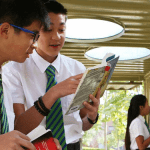
The figure, released by the Australian Bureau of Statistics, comes off the back of strong enrollment growth within the country in early 2016, driven by Chinese students, and improves upon the previous financial year’s record figure of $19.7bn, after a Deloitte report upgraded the value earlier this year.
“These new statistics highlight the strength of our international education sector now worth $20.3bn and our third largest export,” said Education Minister Simon Birmingham in a statement.
“As well as skilling people from all over the world and building Australia’s reputation abroad, international education supports 130,000 jobs in Australia and also delivers significant income for accommodation, hospitality and services sectors in every Australian state.”
As well as valuing direct revenue through fees, the ABS also factors in indirect economic contributions made by the industry, through goods and services consumed by international students and institutions.
The ABS valuation of $19.8bn was further improved by revenue received through additional services performed offshore, worth $450m in 2015/16, to come to $20.3bn.
Growth was experienced across all sectors, with schools and vocational education following New Zealand’s example, and leading growth with roughly 15% and 13% increases respectively.
Higher education, meanwhile, grew by around 10% but is still Australia’s largest contributor of international students and attracts over two thirds of the total revenue generated by the international education industry. It alone is now worth an estimated $13.9bn.
“The growth in the numbers reflects Australia’s excellent reputation for delivering a world-class education in one of the world’s best locations,” said Universities Australia chief executive Belinda Robinson.
“But the real value of international education to all of our students – international and domestic – and to Australia at large goes well beyond the financial benefits,” she added, pointing to the benefits international student connections bring to Australia’s future ties in trade, business, diplomacy, tourism and regional security.
The ELICOS sector experienced a comparatively modest increase, improving by $12m or 1.2%, but retained its position as Australia’s third largest value sector and remained above the $1bn mark.
English Australia CEO, Brett Blacker, said modest growth was due in part to “a trend for students to study shorter periods of ELICOS,” adding the result “mirrors sector growth of 4.8% in student visas over the same period.”
He told The PIE News he anticipated the sector would see an upturn after year to August commencements were up 3.3% from the previous year.
He’s cautiously optimistic outside influences may contribute to a surge in student numbers and revenue in the coming months and year.
Anecdotally, interest and enquiries are up potentially due to Brexit and other global factors, however there has not been a noticeable impact from these foreign nation policy initiatives to-date,” he said.
After three years of growth, the future of Australia’s international education industry looks bright, however Phil Honeywood, CEO of International Education Association of Australia, cautioned the industry is still susceptible to political and market changes.
“Before we get too ambitious, our immigration department is already much more closely monitoring student visa applications on national security grounds,” he warned, adding that more scrutiny had been placed on students from traditionally low-risk countries.
“International education in Australia has always been a rollercoaster ride industry. Anything could happen to turn a boom into a bust.”
The latest figures were released in the lead up to the first meeting on November 22 of the Council for International Education established to oversee and advise on the implementation of the $12m National Strategy for International Education 2025.
[Source:-THE PIE NEWS]







